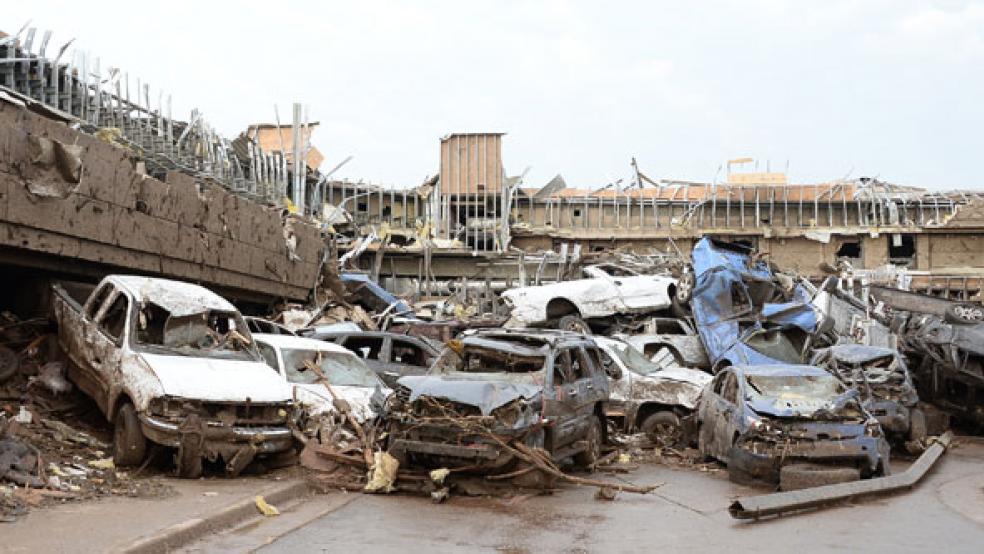The worst of it lasted for about an hour. But the human, physical and economic toll in Oklahoma will rank among the most devastating weather events of its kind. "This is going to be one of the top five costliest tornadoes in U.S. history," said Evan Gold, vice president of client services at Planalytics, a weather consulting firm.
The full impact of the human loss was still unknown Tuesday as exhausted rescue workers searched for survivors among the piles of rubble and collapsed structures left behind in the mile-wide path of the killer storm in Moore, Oklahoma. The effort was hampered by piles of debris, damage to roadways and heavy traffic.
Local officials said 24 were confirmed dead, including eight children. Hospitals reported dozens more were being treated for injuries, at least 65 of them children.
RELATED: 4.5-Mile Tornado Disaster Strikes Okahoma
It will take months to assess the economic damage. Preliminary estimates are often subject to wide revisions. "We're still trying to piece together what the track and intensity it was, but the early computer model estimates are $1.2 billion to $2 billion," Chuck Watson, director of research and development at Kinetic Analysis, told CNBC Tuesday.
As with most storms, the aftermath will likely produce an overall, short-term boost to the region's economy as insurance claims are paid and rebuilding begins. But many individual businesses and households may never fully recoup their financial losses. Residents of Moore are already cruelly familiar with the human and economic loss they've suffered, having survived a similar tornado strike on May 3, 1999.
That twister, with winds clocked in at 318 mph, the fastest ever recorded, left a path of destruction that killed 46 people and damaged or destroyed more than 8,000 homes. The 1999 tornado resulted in some 146,000 claims and $1.4 billion in insured losses, according to Robert Hartwig, president of the Insurance Information Institute.
RELATED: The Coming Storm: Unsustainable Federal Disaster Costs
The Moore tornado will most likely fall at No. 3 on the list between the Joplin, Mo., twister in 2011, which cost $3 billion, and the earlier Moore tornado in 1999 at about $1.5 billion. The most costly tornadoes were cluster of up to 100 in six Southern states on the same day in April, 2011, which cost $11 billion in damages.
The National Weather Service said Monday's Moore twister produced winds of up to 200 mph, putting it in the second most powerful category of a tornado. Most of the economic loss was produced by the obliteration of whole neighborhoods, as thousands of homes were flattened. The destruction was so complete that local crews were installing street signs so residents could locate the site of their homes.
The town will also face the cost of rebuilding a local school and other public facilities damaged by the storm. Utilities were already at work Tuesday rebuilding damaged power lines.
Much of the cost will be offset by insurance and federal disaster assistance. President Barack Obama directed the Federal Emergency Management Agency to prepare to get "all available assistance" to the disaster-hit area. Late Monday, the president declared Oklahoma a major disaster area, making federal aid available to people in Cleveland, Lincoln, McClain, Oklahoma and Pottawatomie counties.
TORNADO CAUSES DOZENS OF DEATHS
The death toll is expected to rise, reports The Weather Channel's Jim Cantore, as the search continues for survivors after yesterday's devastating twister swept across the Midwest. While recent hurricanes have left some homeowners high and dry without insurance coverage, Hartwig said the survivors of the Moore twister are more likely to see their losses covered. That's because coverage for wind damage is more commonly included in homeowner policies than flood coverage, he said.
"It doesn't matter how a fast the wind was or if wind blew off the roof and let water in or hail damage. All of that would be covered whether it's a home or a business," he said.
Thanks to improvements in weather forecasting and warning systems storm-prone communities, death tolls from twisters have been falling in recent years. The deadliest tornado on record, which struck March 18, 1925, killed 695 people in Missouri, Illinois and Indiana. But economic losses have spiked as the frequency and severity of tornadoes and thunderstorms have surged. "Even after you adjust for inflation, the last five years have been the five most expensive years ever," said Hartwig.
About a third of those losses came in just a two-month period, in April and May, 2011, when five clusters of tornadoes swept through the south and Midwest, killing 545 people and leaving a devastating path of destruction. The total cost of rebuilding came to nearly $27 billion, according to theNational Climatic Data Center.
The severity and frequently of destructive storms is expected to continue. While some skeptics debate the causes of more frequent severe weather events, there appears to be little doubt about the economic impact.
"Whether you believe that the volatility in weather is due to natural cycles or whether its man-made, from our perspective it doesn't matter," said Gold. "The fact is there is more volatile weather today. Storms are more severe and more violent, and we have to prepare for that."
This article by John Schoen of CNBC originally appeared at CNBC.com.
Read more at CNBC:
Oklahoma Tornado Damage Could Hit $2 Billion: Expert
Killer Tornado: Scenes from Oklahoma
6 of the Worst Twisters in History



